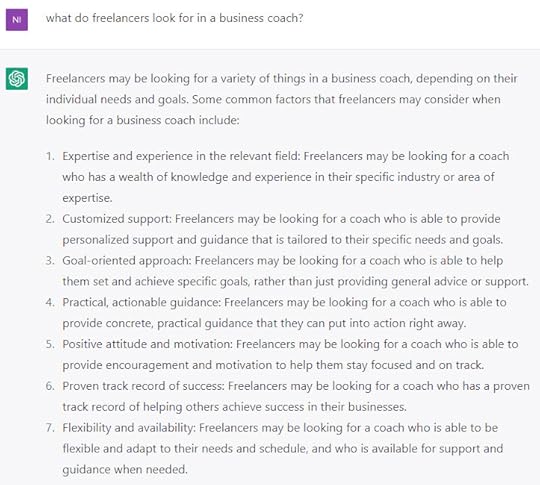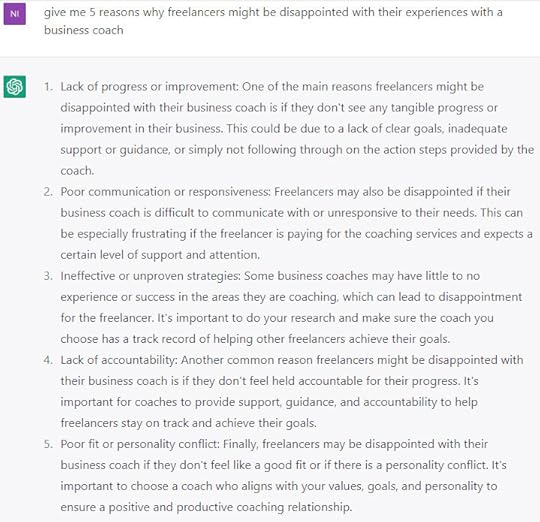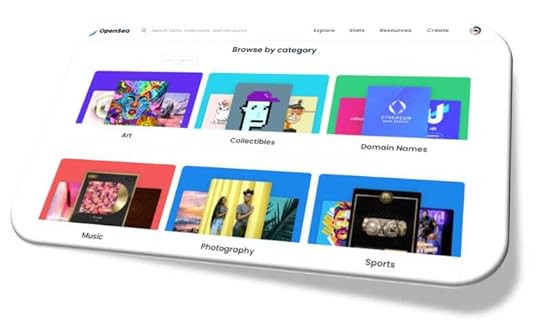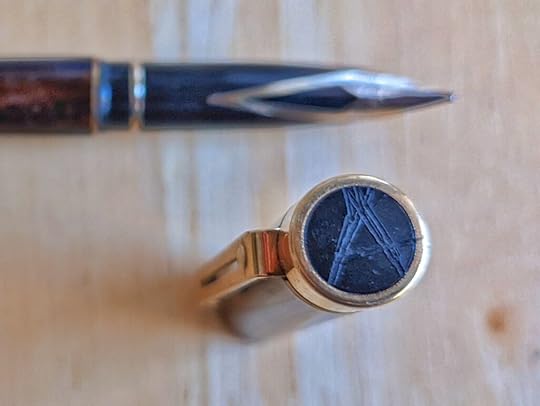Nick Usborne's Blog, page 8
January 16, 2023
After working alone for over 35 years, I now have a full-time assistant. And it’s an AI.

I’ve been using ChatGPT a lot recently. But for the most part, I haven’t been using it to write content or copy.
I’ve been using it as a brainstorming buddy and an information-cruncher.
As an example, here’s how I’ve been using ChatGPT to help me update the coaching page on my website.
I used to do a lot of one-on-one coaching with freelancers. Then I paused for a while. This year I’m going to start again. But before I do any promotion, I wanted to update my information page.
First, I thought I’d do a little brainstorming.
Hmm… I wonder if I can Zoom with a friend. Like right now?
Probably not. But that’s OK, because I have ChatGPT at my fingertips.
Here’s the question I asked, and the suggestions it gave me.

That’s a pretty good start. If I want more, I can simply rephrase the question or prompt.
Then I thought I’d explore the flipside of the question.

Not bad, right?
This is super-powerful, because understanding a prospect’s possible objections gets us much closer to crafting the right message.
That said, I’m not going to take any of those answers as gospel. But this is still a great tool for brainstorming and coming up with new ideas and approaches.
Next, I wanted ChatGPT to help me make sense of a collection of coaching testimonials I’ve received over the years.
I copied and pasted about 25 testimonials into the chat field and asked ChatGPT to go through them all and pick out the positive input that cropped up the most.
It did a great job of that. I then asked it to write me one “pretend” testimonial that captured the essence of the 25 real ones I had shared.
This is what it came up with:
“Working with Nick as my coach was a game changer for my freelance business. Not only did he help me focus on my specific areas of strength and guide me away from unprofitable paths, but he also provided the motivation and accountability I needed to take my business to the next level. His expert understanding of the freelance world and his enthusiasm for my career path were invaluable, and I’m grateful for the clarity and direction he provided.”
Pretty amazing. Imagine trying to tackle that kind of task without an AI to help you.
And I know, this is sounding more and more like a promotion for my coaching services.
I guess it is. But it’s also the best case study I have in support of using ChatGPT as an assistant or researcher.
ChatGPT feels oddly human too.The greatest limitation of of AI systems like ChatGPT is that they’re not human, and don’t have emotions.
They score very badly when it comes to emotional intelligence.
But that doesn’t mean, as a human, I can’t project my own emotions onto the AI.
Surprisingly, I feel a certain affection for ChatGPT when I’m working with it.
I get the sense I have someone at my side, someone to bounce ideas off.
It’s not the same as working with a living, breathing human being. But it does feel better than working alone.
So forgive me if I feel a small sense of companionship when I fire up my AI.
And after a year or two or five, I imagine I’ll have my own, customized and personalized AI to help me with my work, email, bookkeeping and more.
Interesting times!
In the meantime, if you haven’t tried ChatGPT yet, give it a whirl.
The post After working alone for over 35 years, I now have a full-time assistant. And it’s an AI. appeared first on Writing for the web - online copywriting and content writing..
October 17, 2022
Tap into the power of radical responsibility.

I’m not the first person to talk about this approach to life and work.
But I have been applying it to my own life and career for longer than most people. Decades. I’ve also been teaching it to my kids from an early age.
What is “radical responsibility”?
At its simplest, it’s about taking responsibility for the circumstances and situations in which you find yourself.
For example, if I’m finding it harder than usual to pick up new writing projects, even from existing clients, it would be tempting for me to say something like…
“It’s the economy. Companies are cutting back on their expenses.”
Or I might have been sent an email by a client saying the work I just submitted was off-brief…
“The client’s brief was totally unclear. I had no chance to deliver great work.”
In each of these cases I’m placing responsibility for my circumstances on external forces… the economy, my client.
Good reasons. Totally legit. I’m not wrong.
But still…
When you blame your situation on external forces, you are giving up the power to direct your own life.Think about that.
If I blame the economy for my lack of new gigs, I’m giving up the power to change my own life.
After all, if it’s the economy’s fault, I’m powerless. I certainly can’t mend the economy.
Same with the example of a client writing a poor brief. I can’t miraculously transform him into a great writer of briefs.
I’m pretty much saying, “Hey, it’s not my fault. This is out of my control.”
And that makes me a victim. I’m a victim of circumstances.
Now I have the mindset of a victim.
I’m no longer in the driver’s seat. I’m sitting in the passenger seat of a vehicle being driven by someone or something else.
I’m a passenger feeling sorry for himself.
This is why you need to take radical responsibility for everything that impacts your life and your work.OK, so the economy sucks. What are you going to do about it?
How are you going to adapt? What new opportunities might this present?
How can you help clients and prospects as THEY adapt to a tough economy?
In other words, even if the poor economy is having a real impact on millions of people, that doesn’t mean you have to lie belly-up on the floor and blame it for your falling income.
Instead, stand tall, take radical responsibility for your own career, and find ways to use your skills to help clients who are being impacted by the same challenges.
Same with the client who can’t write a decent brief.
Don’t throw up your arms and say, “Not my fault”.
Instead, take radical responsibility for your situation. Stay in the driver’s seat. Next time, before you start on the project, send him a follow-up email asking for clarification on any sections of the brief you feel are missing or ambiguous.
After that, as you think about how the business world is probably filled with marketing managers who don’t know how to write a decent brief, write and publish an eBook on best practices when writing briefs for freelancers.
Now you’re a published author. You’ve taken back control.
Apply radical responsibility to everything in your life.In work and in our personal lives, we constantly make excuses.
It’s my client’s fault. It’s the government’s fault. It’s the bank’s fault. It’s the teacher’s fault. It’s the neighbor’s fault. It’s my partner’s fault.
Poor little me. Not my fault. I’m the victim here.
Well, it doesn’t have to be that way.
As soon as you accept total responsibility for what’s happening around you, you take back power over your own life.
No longer the victim of unfair circumstances, but the driver of your own destiny.
I’m not saying it’s easy. And I sometimes catch myself playing the role of victim.
But feeling like a victim is a miserable state of mind.
I’d rather empower myself and take responsibility for my next steps.
I like to be the boss of my next moves forward, mistakes and all.
Radical responsibility!
The post Tap into the power of radical responsibility. appeared first on Writing for the web - online copywriting and content writing..
March 23, 2022
Why I’m creating a new course on writing for Web 3.

Every two or three years I create a new course for digital copywriters and content writers.
Next up is a course for writers who want to take advantage of the huge growth in the area of Web 3.
Hang on, you ask… what the heck is Web 3?
And what happened to Web 1 and 2?
A brief history of the web…Web 1 covers the early years of the web, from the late 90s into the new millennium. Think AOL, CompuServe and big media companies coming online.
That was also a time of message boards and early blogs, where people got a taste of being able to have their say online as individuals. Even the early Internet gave individuals a voice. But mostly Web 1 was about sites publishing information “at” us.
Web 2 rose up in tandem with the growth of social media. Let’s say from 2006 or so onwards. Now the voices of individuals grew louder. Millions of people took to Twitter, Facebook, YouTube and other platforms to share their news, likes and dislikes.
For a while it felt like social media might truly democratize the web. And then it became clear that these huge platforms were simply monetizing our attention, selling our personal data, and ruling the web.
That brings us to Web 3, which is something entirely different… hopefully.
Web 3 is an iteration of the Internet that is being built on blockchains.Public blockchains are decentralized. Unlike Facebook or Google, no company owns the Bitcoin or Ethereum blockchains. There is no central authority.
This kind of open infrastructure opens up new opportunities for developers, creators and users.
Blockchains enable DeFi… decentralized or disintermediated finance. With blockchains I can send you money in the form of a cryptocurrency, without the help or permission of an intermediary, like a bank or PayPal. From me to you directly.
According to a recent Morning Consult report, 20% of American adults, and 36 percent of millennials own cryptocurrency.
And many of them also own at least one NFT, or Non Fungible Token.
An NFT is simply a digital asset of some kind, where your ownership of that asset is immutably recorded on a blockchain.
An NFT could be a piece of digital art. Or a photograph. Or a song. Or a video clip of a sporting moment. Or membership of a group. Or a ticket to an event. Or an item or avatar in a video game. Or a pfp you can use as a profile picture for your social media accounts. Or a plot of land in the metaverse.
Just today I purchased a piece of digital art as an NFT. The art series was sponsored by Stella Artois as a fundraiser in support of Water.org. Within 2 hours they raised $277,515.86.
Why is there even a market for copywriters and content writers in the world of Web 3 and NFTs?Because the NFT market in particular is huge, currently valued at about $40 billion.
And because over 1,000 new NFT projects are being launched each week… over 50,000 projects a year.
Each of them needs a website and a strong social media presence.
That’s just the new NFT project launches, and doesn’t include all the traditional companies that are looking to add NFTs to their offers.
For example, I have a client that sells a fitness app… and is now relaunching with crypto tokens and in-app NFTs.
You can keep up with which big brands are jumping on the NFT bandwagon through this page on AdAge, which they constantly update.
Some recent entries include…
Papa Johns today dropped its first collection of NFTs—a series of handbag designs inspired by the pizza delivery bag.In honor of the automaker’s new 2023 Integra, Acura is turning the car into an NFT. Acura will also open a digital showroom in the metaverse, called Acura of Decentraland,Duke University announced it will drop a collection of NFTs inspired by its men’s basketball team.Jeans retailer Wrangler announced an upcoming NFT auction celebrating singer-songwriter and long-time Wrangler fan Leon Bridges.Here’s the opportunity for digital copywriters and content writers…Like I said, all these new projects and ventures need either a whole new website, or the addition of pages to an existing website.
Plus social media, email marketing, press releases, blog posts and more.
In other words, this is a whole new industry, a whole new category.
As a writer, you can bring all your existing skills into this space.
But… not everyone is going to be able to do that.
How come?
Because it takes a lot of time and effort to become fluent in the language and culture of Web 3, crypto, and NFTs.
I’ve been deep down this rabbit hole for over 18 months now. I work with clients in this space. I have a collection of NFTs. In other words, I have skin in the game.
But still… I have to work hard to keep abreast of what’s new today and coming next.
Blockchains, cryptocurrencies, tokens, DeFi, NFTs, pfps, minting, wallets, Metamask, secondary marketplaces, the metaverse, rug pulls… and so on.
The copywriters and writers who want to profit from this area… and there are billions of dollars in play… are those who choose to invest time in becoming absolutely fluent in the culture, processes, language and terminology of this space.
That’s why I’m already mapping out a new course for writers who want to enter the Web 3 industry.
The curriculum for the course will include a deep dive into the culture and language of this space. And it will show you how to write about crypto for different media … up to and including media in the metaverse itself.
I don’t know when or where the course will be published. To be determined. But I’m already working on it.
If you’re interested, and you’re not already subscribed to my newsletter, sign up now and I’ll keep you up to date with my progress.
The post Why I’m creating a new course on writing for Web 3. appeared first on Writing for the web - online copywriting and content writing..
January 14, 2022
Should you be selling the product, or the story?

Imagine walking into someone’s home, looking around and seeing a family photo on the wall.
Not a posed family portrait. More of a goofy shot. Not terribly well composed. Maybe even a little bit out of focus.
Seeing you study the picture, your host comes over and says, “Oh my goodness, let me tell you the story behind that photo!”
It isn’t the photo that has the true power… it’s the story behind the photo.
It’s the story that carries the true emotional punch.
Let me share a couple more stories with you… one personal and the other professional.
We’ll start with the personal story.
It’s an expensive pen.About 25 years ago I gave a talk about writing for the web. It wasn’t a large audience… just a few people from an ecommerce start-up.
I don’t think I was paid a fee, but they did give me a beautiful Sheaffer pen set. I loved the fountain pen in particular.
Anyway… a little while back my wife asked if she could take it with her to a writing workshop. I said yes, of course, but asked her to be super-careful not to lose it.
I asked her to be careful not because of the pen, but because of what happened to the pen a couple of years after it was given to me.
One of my sons, in a moment of teenage angst, scratched the A for anarchy symbol on the top of the pen’s cap. At the time I was pretty upset. It felt like he had ruined the pen.
But today… that A etched into the pen cap is what makes it so precious to me. It defines a moment in my relationship with my son. When we talk about it now, we laugh.
That’s why I asked my wife to be careful. Not because of the pen, but because of the memory… the story.
OK… now for the business example.I’m on the email list for Cirino’s Bloody Mary Mix.
Jerry Cirino is the boss of his own restaurant, as well as being the creator of the restaurant’s own brand of Bloody Mary Mix, which he sells online.
In his latest email he wrote about how he’d heard from one of his customers, who said she was a happy customer, but would no longer be buying his mix.
That’s an interesting opening to a story! There’s intrigue there… unanswered questions. Why is she no longer buying Jerry’s mix? And can Jerry save the day?
It turns out she has become a vegan and discovered there were anchovies in the Worcester sauce that is an ingredient in the mix.
She’s still happy to recommend the mix to her friends, but she won’t be ordering any more for herself.
This got Jerry thinking about what it would take to create a vegan version of his Bloody Mary Mix.
The point is… from the start to the finish of his email, Jerry was sharing this story with us… the story of a lost customer, and potential opportunity for the future.
This isn’t a big story… it’s a small, everyday kind of story.
But it reveals a lot about Jerry and his business.
He didn’t write and say, “We listen to our customers”. Instead, he told a short story about something that happened while he was listening to an individual customer.
He could have talked about how his company is committed to product improvements… the usual marketing blah blah blah.
Instead, he shared the story of his email conversation and showed to us that he really is interested in product improvements.
In the process, we got to know Jerry a little better. And we got to like him even more.
That means we are more likely to keep buying from him.
He didn’t write an email pitching his mix. He simply shared a quick story.
And it was a story that made us feel good.
Stories have super-powers…In answer to the question I posed in this post’s headline… yes, you should sell the story, not the product.
The story behind my scratched pen packs a more powerful emotional punch than talking about the pen itself.
The story of Jerry’s lost customer is more engaging than talking about his Bloody Mary Mix.
We all love stories, and we are all touched by stories.
That’s why the ability to tell a good story is an essential skill for any copywriter.
Which leads me to my course… Selling with Stories.
The post Should you be selling the product, or the story? appeared first on Writing for the web - online copywriting and content writing..
October 16, 2021
The future belongs to short-form copywriters.

It’s tricky making predictions.
But I’m pretty sure there’s going to be a lot more short-form copywriting in the future.
I believe this to be true for two reasons… one is physical, and the other is more connected to our changing lifestyles.
Let’s start with the physical reason.
Our devices our no longer suited to long-form writingI remember when I used to read the news on a large format newspaper.
Those things were really big. Not a problem on a breakfast table, if you could keep the pages out of the marmalade. But they required great dexterity when on a crowded commuter train or bus.
Big format, and lots of space for long news articles. And plenty of space for long-copy ads.
Now let’s jump forward to the first decade of the web, when millions of people turned to their computers for the news.
That was a very different experience.
Unlike a newspaper, online news could be updated multiple times a day. And the user experience was utterly different too. No more turning paper pages. Just clicking and scrolling.
And the content of the pages changed too. There is no online equivalent of those big, full-page or half-page ads we see in newspapers and magazine.
The ads became smaller, and the copy had to be shorter.
Sure, you could write long-form promotional emails, and long-form sales pages that scrolled on and on forever.
Right up until the other foot dropped…
The arrival of smartphones changed everything. Again.Welcome to 2007 and the Apple iPhone. Not the first mobile phone by any means, but the first true smartphone.
Compare that screen size to a newspaper, magazine or desktop computer.
Compared to all devices that came before it, the size of a smartphone screen is ridiculously small.
Who could imagine that people would choose to read and write on such a small device? It makes no sense.
But today, about 50% of all web access takes place through smartphones.
And over 90% of social media activity takes place on smartphones.
Put simply, if you’re a marketer and you want to reach consumers where they spend their time, you need to be on mobile.
And if you want to market your products or services on mobile, you need someone who can write short copy.
The rhythm of our days is now measured in shorter beats.This is the lifestyle reason behind the shift to short-form copywriting.
The rhythm of our days has changed.
The rhythm is faster.
We are less likely to spend an unbroken five minutes reading a single 2,000-word article on our smartphone.
We are more likely to use that same block of time to check our email and our Twitter account, post a comment on Facebook, look at the latest news updates, and check our bank account balance.
More things done, with less uninterrupted time spent on any one of them. Our attention is always on the move.
Shorter beats.
Again, this means using shorter copy. If you try writing long copy for use on a smartphone, you’ll lose most of your readers after the first few lines.
Better to get started now.If you’re a marketer, it’s time to think about how to create these short-beat promotional messages.
If you’re a digital writer or copywriter, you need to start figuring out how you can meet your audience where they’re at, and deliver your messages with far fewer words.
Enjoy the challenge!
The post The future belongs to short-form copywriters. appeared first on Writing for the web - online copywriting and content writing..
July 20, 2021
The true secret to great copywriting is…

If you’re a student of copywriting, you’ve likely come across various experts promising to share their secrets to success.
A lot of these promises come in the form of methods, templates, roadmaps, strategies… and so on.
In other words, “Follow this proven process and you’ll be a super-successful copywriter. Six figures and beyond!”
Get the book, course or coaching program, and you’ll have access to their amazing, super-powerful, 10-step method.
I’m not saying these “follow-the-process” methods don’t ever work…
But they’ve never really worked for me.
As I look back at the most successful projects I have written over the last few decades, not one of them relied on any kind of process, template or method.
But they did all have one thing in common…
My own secret to copywriting success is…Raw energy.
And that’s pretty much it.
I do my best work when I’m ridiculously excited about the project.
Maybe you’ve seen me at one of my high-energy moments… on a stage or on Zoom.
I become weirdly intense. Disproportionately excited. A diagnosis waiting to happen.
That’s when I write my best copy, because that’s when I’m able to pump a huge amount of positive energy into my writing.
That kind of energy is irresistible. It compels attention. There’s no ignoring it.
People keep reading… and then a good number of them say yes to whatever it is I’m asking them to do.
How to get into that kind of positive energy mindset.There is no magic process. No easy button.
But I do know this…
If I want to get into this kind of mindset, I have to really like the product or service I’m writing about. I need to find it super-interesting. It helps if I really like the client too.
For projects that don’t excite me in quite such an intense way, I’ll do my usual, professional work. I’ll always do the best work I can.
But for my very best work… I have to feel that pressure of positive energy building and building, until it finally bursts out, and finds expression in my writing.
Might this work for you too?I bet it could.
Seek out the kinds of projects you think you’d truly enjoy.
Look for project types that get your juices flowing. Approach prospective clients you REALLY, REALLY want to work with.
Then put all that positive energy to work.
Taking one step back…Don’t get me wrong. I’m not suggesting you ignore the basic principles of structuring a strong page of copy or content.
You still need a solid beginning, middle, and end.
You still need that framework.
But it’s what you add on top of that framework or template that creates the magic.
It’s the energy you share with your readers that brings your page to life.
The post The true secret to great copywriting is… appeared first on Writing for the web - online copywriting and content writing..
July 1, 2021
3 Benefits of writing better subheads.

Hopefully, you pay a lot of attention to writing your headlines.
I do.
I typically go through several drafts until I’m reasonably happy with a headline.
Headlines are important, because a good one captures attention and inspires people to start reading the body text. Bad headlines don’t.
Truth be told, I’m a bit of a headline nerd. I created an entire course on how to write them.
But… there’s more.
What about those subheads?
How much time do you spend on writing subheads?
Based on my own observations, writers often don’t bother writing subheads at all or – if they do – they rush them.
Pity.
Because I can think of at least three good reasons why you should spend time writing better subheads.
Benefit #1: Subheads create a framework for your post or page.On very rare occasions I’ll write an entire post without any subheads at all. Almost as if I’m writing a letter home.
But mostly, I include subheads as a way to structure or frame the post. Most of my posts, whatever the topic, are written in three parts.
The intro. The body. And the close or conclusion.
The intro follows the main headline. Then subheads introduce both the body and the close. I may have a few subheads within the body, like I’m doing with this post.
My work process is simple.
I start with a blank page and then write version one of my headline.
Then, before writing any body text, I write my subheads.
Now I have my framework.
With my headline and subheads in place, writing the post becomes pretty straightforward.
I know what I’m going to write, and I know the order in which I’m going to write it.
Benefit #2: Quality subheads keep your readers engaged.Creating a framework and structure for the post does more than help me, the writer. It also helps the reader.
The reader can scan the page and get a good sense of where everything is leading. It gives her confidence that your post is worthy of her continued attention.
When writing subheads, I apply a lot of the same thinking as when I write headlines.
I don’t simply write a few generic words as a way of saying, “next section starts here”. I’m more specific. I want to give my readers a hint of what’s to come. To inform, and maybe to tease a little.
In other words, write your subheads in a way that motivates your audience to keep reading.
Benefit #3: Optimized subheads help attract more search engine traffic.If you publish your own posts and pages, your page heading is usually tagged as the H1 heading automatically.
Then you add your text, and some subheads.
How do you show your subheads as being separate from the body text? Some people just use regular text, and then make it bold.
That’s a huge missed opportunity.
You should tag your subheads at H2 headings.
If you have some sub-subheads, tag them as H3.
This way Google gets a clear message as to which lines to pay the most attention to.
I always tag my subheads as H2. I also try to include the keyword or phrase for which the page is optimized. Or a related keyword or phrase.
Remember, it’s not just your readers who pay attention to your subheads. The search engines do too.
Writing better subheads can quickly improve your posts and pages.I used to be more than a little lazy about writing subheads.
It took me a while to realize how important they are, and how helpful they can be… to me as a writer and to my readers.
Long story short, paying more attention to writing good subheads is a powerful way to create content that ranks better with both your readers, and the search engines.
NOTE: My course on writing headlines? You can find out about it here…
The post 3 Benefits of writing better subheads. appeared first on Writing for the web - online copywriting and content writing..
March 12, 2021
Tell a simple story that engages your readers emotionally.

It doesn’t have to be a big, dramatic story.
It can be something simple.
Like how my wife cried when she walked to the local corner store to buy chips, but realized she didn’t have a mask with her. So she couldn’t go in.
Her tears weren’t about the chips.
We know that.
Her tears were about the relentless grind of living through a pandemic, where something as simple as buying chips is sometimes out of reach.
We know how she was feeling. We’ve all felt that.
And that’s the power of stories. Even small stories.
A story engages us quickly, and can bind us at a deep level through shared experiences and emotions.
That’s why so many newspaper articles open with a story.
For example, if you want to write an article about how hard the pandemic has been on single mothers, don’t kick off with quotes from a politician or a bunch of statistics.
Write about Sandra, who is working from home as a customer service rep for a cell phone company, and is trying to home school her kids at the same time.
Take a snapshot of part of her day as she struggles to keep everything in balance. Tell her story.
When you open with a story, you invite your readers to empathize.
And when they empathize, their emotions are quickly engaged, and they are more likely to keep reading.
That’s a lot more powerful than the latest blah blah from a politician.
And a lot more compelling than yet another chart.
But put in the work to tell a true story…Direct marketers have known about the power of stories for a long time.
They definitely know about the power of emotion when it comes to engaging readers.
So many of them do exactly what I’m talking about here.
They open with a story.
The trouble is, more often than not, it isn’t a true story. It’s fiction.
There’s nothing wrong with a good fictional story.
Except for when it’s masquerading as a true story.
People are really good at sniffing out made-up stories. Humans have amazing “story radar”.
A story that isn’t true won’t have the emotional impact you’re looking for.
For example, I hope the story about my wife in tears outside the corner store felt true… because it is true. I asked her permission to use it in this post.
Telling stories can be a digital marketing superpower.It doesn’t matter whether you’re writing sales copy or web content, stories can be your best friend.
In an email, on a landing page, as the opening to a blog post, or at the heart of a social media post… stories tap into the emotions of your readers.
And that’s where you want to be. You want to be in their hearts, before you appeal to their brains.
If you want to know more, I offer a full course on Selling With Stories.
The post Tell a simple story that engages your readers emotionally. appeared first on Writing for the web - online copywriting and content writing..
January 22, 2021
When you’re lost in the forest, and a digital marketing expert offers to help…

If you have a business, or you advise or write for business, the web can be an amazing, but thoroughly confusing place.
Whether you want to learn more about email marketing, sales funnels, social media or chatbot marketing, there are a thousand experts ready and waiting to help you.
The trouble is, which experts should you follow? Which one teaches or offers the approach that will work best for your audience?
And, of course, you have to figure out which are the true experts, and which are the weekend gurus who likely know less than you do.
Here is my take on this, in three steps.
Step 1: Invest time on research and then stay the course.Whenever I want to learn something new – and that happens a lot – I do a deep dive into the topic. Really deep. Way down the rabbit hole.
While learning about the topic, I’m also trying to figure out who the true experts are.
I’m quick to dismiss self-proclaimed “experts” who are full of noise, drama and urgency. I’m looking for the real thing.
And who can I trust? Who feels like a good match for what I’m trying to learn and achieve?
Once I’ve found a couple of experts I feel good about, I stick with them. I stay the course.
I don’t totally ignore everyone else. I keep an open mind. But my two top choices become my keel and my compass. They keep me moving forward in a clear direction. No distractions. Minimal noise.
Step 2: Remember that you know your audience and your vision the best.A while back I invested in some advice from an expert in one of the major social media channels.
He’s widely respected in his field of expertise, and he and I got on really well together.
But… although his advice was sound, and proven in many ways… its wasn’t a good fit for my brand and my audience.
I should have figured this out on my own, and much faster than I did.
In fact, I was finally tipped off by a customer of mine who emailed me and asked what had happened to my “voice”. He wanted to know why I was sounding “off” on that particular channel.
The takeaway here is that while experts may know a lot more than you do about various aspects of digital marketing, you’ll always know more about your own audience, brand and voice.
Don’t let outside experts mess with that.
Step 3: Take this advice from a Norwegian soldier deep in the forest.Back when I was in my late teens I went on a school trip to Norway.
We were guests of the Norwegian army, way out in the back of beyond.
One day we were sent out in small groups, hiking to certain points in the forest. We had to find our way there, and back, armed with a map and compass. (No smartphones back then!)
I don’t remember much about that day.
But I do remember the advice the army officer gave us before we left.
He said:
“This is wild and largely uncharted territory. If you look at your map and it disagrees with the land in front of you, always remember it’s the land that is right. Not the map.”
That piece if advice hit me like a hammer blow.
I have always remembered and lived by what he said that day. Those few words have had a huge impact on my life. It’s so easy to put too much faith in the map. “But look, here it is, in black and white. It must be true!”
And yes, I apply it to my work as a digital copywriter and marketer.
“When advice from the experts is at odds with what you see happening in front of your eyes, it’s what you’re seeing that is right.”
An insight to live by. At least, for me it is.
The post When you’re lost in the forest, and a digital marketing expert offers to help… appeared first on Writing for the web - online copywriting and content writing..
January 2, 2021
Focus on long-term goals, and choose some scary ones.

At this time of year, I always spend a few days reflecting on the year that just passed, and thinking about the year to come.
This year, before thinking too much about what’s to come in 2021, I looked back further than just last year.
In fact, I looked back at the last 10 years.
In particular, I wanted to take a look at the new ventures and projects I had embarked on, and see which of them worked out the best.
Two main takeaways…
Planning for the long term has always worked better for me.
When I’ve tried for “quick wins” it has never worked.
This typically happens when I get all excited about something and create a new project and website… hoping it will deliver a big return in just a few months.
This is short-term thinking, going for a fast and relatively easy win.
Maybe some people have had success with that. But it doesn’t work for me.
What does work for me is when I set goals with a time horizon closer to 5 years.
Now I’m planning longer term. No rush. No unrealistic expectations of fast returns on the time I invest.
This takes a lot of pressure off. I can focus on building something, without being distracted by the numbers.
I have the time to do it right.
No income yet? That’s OK. I hadn’t planned for a lot of income in the first year.
Not much traffic to the site yet? Not a problem. I have time to work on that.
When you set short-term goals, you’re falling into the Easy Button trap.
You want it to be easy to achieve success.
But the Easy Button almost always disappoints.
Give yourself time to build something amazing. Take the long view.
Stretch yourself with an ambitious goal.
This is looking at the Easy Button problem through a different lens.
If you try to achieve a goal because you think it’s going to be easy, you’re setting yourself up for failure.
First, because achieving significant success is rarely easy.
Second, because if it is easy, you’ll have a zillion competitors reaching for the same easy goal. And now you have a huge competition problem.
Also… and this is a big one… trying to achieve something easy will never bring out the best in you. It will never stretch your mind or take you to a whole new level of success.
Tough, ambitious goals demand a deep, enduring and fiercely creative commitment to the project.
Suddenly you have an opportunity to really shine.
And, at least for me, dealing with hard problems and bold goals is a lot more fun.
Bottom line… forget about the Easy Button.
The web is awash with promises of fast and easy success. Your email inbox is filled with them too. And your social media channels.
Empty promises with plenty of glitter to catch the eye.
But that’s not how you’ll find success at a life-changing level.
For that kind of experience, extend your goal horizon, and go for something that’s going to really stretch you.
And while you’re on that longer journey, you’ll have plenty of time to look out the window and see all your Easy Button competitors fall away, one by one.
The post Focus on long-term goals, and choose some scary ones. appeared first on Writing for the web - online copywriting and content writing..
Nick Usborne's Blog
- Nick Usborne's profile
- 6 followers



